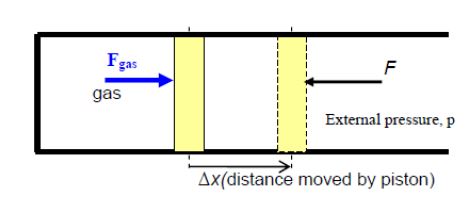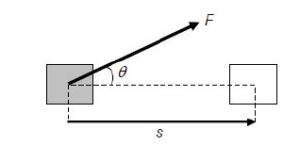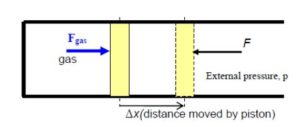Short note on work, energy and power for Students

Short note on work, energy and power for Students (Cambridge A level and UTME)
Workdone by a force is defined as the product of the force and the distance moved in the direction of the force.
W = F x s
F is the force
s is the displacement in the direction of the force
w is the workdone
the unit of workdone is joules
Doing work is a way of transferring energy
Joule is defined as the amount of workdone when a force of 1 newton moves a distance of 1 meters in the direction of the force.

The horizontal component of the force is Fcosθ
workdone = Fcosθ x s
workdone = Fscosθ
Energy
- Energy can neither be created nor destroyed, but can be converted from one form to another (or others).
- The total amount of energy in any closed system is constant
- There is no change in the total energy of the Universe
- Energy and work are both scalar quantities, and have the unit Joule.
Gas doing work
Gas exert pressure on the wall of their container. if a gas expands, the walls are pushed outwards – the gas has done work on it surrounding.
work done by a gas that is expanding against a constant external pressure: W = p .V

Pressure = force / area
cross multiply
force = pressure x area
F = pA
workdone = F X S
substitute for the force
workdone = p x A X S
but the quantity A x s is the increase in volume of the gas, which is ∆v
w = p∆v
we assume that pressure p does not change as the gas expands. This will be true if the gas is expanding against the pressure of the atmosphere, which changes only very slowly.
Derive, from the equations of motion, the formula Ek = ½ mv2
Kinetic Energy gained by an object is equal to the work done on that object
potential energy is the energy an object has because of its position or shape
workdone by a net force = change in kinetic energy of the body
recall that v2 = u2 + 2as
make as the subject of the equation as = ½ v2 – ½ u2
Multiple both sides by m which is the mas mas = ½ mv2 – ½ mu2
F=ma , so Fs = ½ mv2 – ½ mu2
I f an object is starting from rest u = 0
Fs = ½ mv2
Ek = ½ mv2
Kinetic energy = energy associated with a moving object
Recommended: Questions and answers on work, energy and power for A level and UTME
Distinguish between gravitational potential energy, electric potential energy and elastic potential energy
gravitational potential energy : it is the stored energy available to do work due to position of mass in a gravitational field
elastic potential energy is the energy stored in an object which have had their shape changed elastically
G.P.E = mgh
Elastic potential = 1/2 k x^2
show an understanding of the concept of internal energy
Internal energy: is the sum of the random potential and kinetic energies of all the molecules in a body
Internal Energy = Total Potential Energy + Total Random Kinetic Energy
Random Kinetic Energy = Translational Kinetic Energy + Rotational Kinetic Energy
Translational energy is the energy associated with the whole molecule moving in a certain direction.
Rotational energy is the energy associated with the molecule rotation around a certain point.
Potential energy is the energy associated with intermolecular forces
Efficiency = (useful output energy / total input energy) x 100%
Define power as work done per unit time and derive power as the product of force and velocity
Power is defined as the rate of workdone
power = w / t
watt is the unit of power
watt is defined as a rate of working of 1 joule per second
